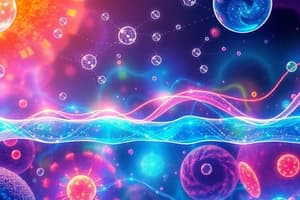Podcast
Questions and Answers
What happens when a molecule is bound with another molecule in the context of a buffer system?
What happens when a molecule is bound with another molecule in the context of a buffer system?
- The effects of the original molecule are enhanced.
- The effects of the original molecule are removed. (correct)
- The effects of the original molecule are amplified through the system.
- The effects of both molecules are combined creating a new effect.
Why is the pH scale used instead of directly stating hydrogen ion concentration?
Why is the pH scale used instead of directly stating hydrogen ion concentration?
- Because the concentration is always a simple integer.
- To amplify slight changes in acidity or alkalinity.
- To make hydrogen ion concentration compatible with other biological measurements.
- To represent hydrogen ion concentrations with smaller numbers. (correct)
Which of the following best describes the action of a base in the context of acid-base regulation?
Which of the following best describes the action of a base in the context of acid-base regulation?
- It neutralizes acidic solutions by adding hydroxide ions.
- It donates hydrogen ions into a solution.
- It converts hydrogen ions to water molecules.
- It accepts hydrogen ions from a solution. (correct)
How does the respiratory system primarily contribute to acid-base regulation?
How does the respiratory system primarily contribute to acid-base regulation?
Which of the following can be described as the most powerful pH regulatory mechanism in the body?
Which of the following can be described as the most powerful pH regulatory mechanism in the body?
What reaction takes place when cellular metabolism produces $CO_2$ in regards to acid base regulation?
What reaction takes place when cellular metabolism produces $CO_2$ in regards to acid base regulation?
What is the primary function of a buffer in maintaining pH levels?
What is the primary function of a buffer in maintaining pH levels?
What is the normal range of intracellular pH, according to the text?
What is the normal range of intracellular pH, according to the text?
According to the principles of reversible reactions, what happens when a reactant is added?
According to the principles of reversible reactions, what happens when a reactant is added?
What is the primary role of carbonic anhydrase in the bicarbonate buffer system?
What is the primary role of carbonic anhydrase in the bicarbonate buffer system?
In the bicarbonate buffer system, if more hydrogen is added, what direction will the reaction be driven?
In the bicarbonate buffer system, if more hydrogen is added, what direction will the reaction be driven?
Which organs primarily regulate the amount of bicarbonate and CO2 in the body?
Which organs primarily regulate the amount of bicarbonate and CO2 in the body?
Why are proteins considered plentiful buffers in the body?
Why are proteins considered plentiful buffers in the body?
How is CO2 primarily eliminated from the extracellular fluid?
How is CO2 primarily eliminated from the extracellular fluid?
Where in the renal tubules does most of the reabsorption of bicarbonate and secretion of hydrogen occur?
Where in the renal tubules does most of the reabsorption of bicarbonate and secretion of hydrogen occur?
Why can't bicarbonate ions be directly reabsorbed in the renal tubules?
Why can't bicarbonate ions be directly reabsorbed in the renal tubules?
How is the reabsorption of bicarbonate facilitated in the renal tubules?
How is the reabsorption of bicarbonate facilitated in the renal tubules?
What is the function of hydrogen secretion by the tubular epithelium?
What is the function of hydrogen secretion by the tubular epithelium?
What process is primarily responsible for severe respiratory alkalosis?
What process is primarily responsible for severe respiratory alkalosis?
Which of the following can cause metabolic acidosis?
Which of the following can cause metabolic acidosis?
What is one mechanism by which diuretics can cause metabolic alkalosis?
What is one mechanism by which diuretics can cause metabolic alkalosis?
What does a base excess indicate in acid base balance?
What does a base excess indicate in acid base balance?
What is the normal range for the anion gap measure?
What is the normal range for the anion gap measure?
Flashcards
pH
pH
A measure of the acidity or alkalinity of a solution, based on the concentration of hydrogen ions (H+).
Acid
Acid
A substance that can donate hydrogen ions (H+).
Base
Base
A substance that can accept hydrogen ions (H+).
Acid-Base Regulation
Acid-Base Regulation
Signup and view all the flashcards
Buffer
Buffer
Signup and view all the flashcards
Bicarbonate Buffer System
Bicarbonate Buffer System
Signup and view all the flashcards
Respiratory System (Acid-Base Regulation)
Respiratory System (Acid-Base Regulation)
Signup and view all the flashcards
Kidney (Acid-Base Regulation)
Kidney (Acid-Base Regulation)
Signup and view all the flashcards
Le Chatelier's Principle
Le Chatelier's Principle
Signup and view all the flashcards
Buffer Capacity
Buffer Capacity
Signup and view all the flashcards
Carbonic Anhydrase
Carbonic Anhydrase
Signup and view all the flashcards
Respiratory Regulation of pH
Respiratory Regulation of pH
Signup and view all the flashcards
Renal Regulation of pH
Renal Regulation of pH
Signup and view all the flashcards
Respiratory Acidosis
Respiratory Acidosis
Signup and view all the flashcards
Respiratory Alkalosis
Respiratory Alkalosis
Signup and view all the flashcards
Metabolic Acidosis
Metabolic Acidosis
Signup and view all the flashcards
Metabolic Alkalosis
Metabolic Alkalosis
Signup and view all the flashcards
Anion Gap
Anion Gap
Signup and view all the flashcards
Base Excess
Base Excess
Signup and view all the flashcards
Hydrogen ATPase
Hydrogen ATPase
Signup and view all the flashcards
Hydrogen-Potassium Countertransporter
Hydrogen-Potassium Countertransporter
Signup and view all the flashcards
Bicarbonate Reabsorption and Hydrogen Secretion
Bicarbonate Reabsorption and Hydrogen Secretion
Signup and view all the flashcards
Study Notes
Acid-Base Regulation
- Body's enzyme systems are highly sensitive to hydrogen ion concentration, impacting numerous bodily functions.
- Normal hydrogen ion concentration is critically low (e.g., sodium levels are millions of times greater).
- Substances donating hydrogen are 'acids', while those accepting hydrogen are 'bases'.
- Hemoglobin and red blood cells are significant bodily bases.
- Weak acids/bases, not strong ones, are primarily discussed in these notes.
- Dissociation constant (k) relates acid concentration to dissociated ions.
- pH scale (negative log of hydrogen ion concentration) simplifies dealing with very small numbers.
- Arterial pH is typically 7.4, while venous pH is around 7.35.
- Cellular metabolism generates CO2, forming carbonic acid, reducing pH.
Acid-Base Regulation Systems
- Three main systems regulate hydrogen concentration:
- Chemical buffer system (acts quickly, in seconds)
- Respiratory system (acts within minutes, controlling CO2 removal)
- Renal system (acts over hours/days, the most potent system)
- A buffer reversibly binds hydrogen, neutralizing its effect (example: drugs).
- Le Chatelier's principle suggests adding a reactant drives the reaction to the opposite direction.
- Bicarbonate buffer system (CO2 + H2O ↔ carbonic acid ↔ hydrogen ions + bicarbonate).
- Carbonic anhydrase accelerates the CO2-to-carbonic acid reaction.
- Kidneys regulate bicarbonate levels; respiration regulates CO2 levels.
- Proteins are crucial body buffers due to their abundance and ability to bind hydrogen.
Acid-Base Regulation in Extracellular Fluid
- Controlling extracellular fluid CO2 is crucial (excreted through ventilation).
- CO2 is continually produced by cellular metabolism.
- Alveolar ventilation rate is affected by hydrogen ion concentration.
Acid-Base Regulation in the Renal System
- Hydrogen and bicarbonate continuously filter into renal tubules.
- Bicarbonate reabsorption and hydrogen secretion in renal tubules regulate pH.
- Bicarbonate isn't directly reabsorbed; it combines with hydrogen to form carbonic acid, which dissociates into CO2 and H2O.
- CO2 diffuses readily and recombines to form carbonic acid, generating bicarbonate and hydrogen, and then both are reabsorbed through transporters.
- Hydrogen is actively secreted into the tubular fluid, significantly increasing its concentration.
Acid-Base Regulation (cont'd)
- Phosphate and ammonia are also important renal buffers.
- Acidosis (low pH) is due to impaired respiratory centers or conditions increasing CO2 elimination; alkalosis (high pH) occurs from excessive ventilation.
- Metabolic acidosis is from causes besides excessive CO2 (diarrhea is common).
- Metabolic alkalosis results from bicarbonate retention or hydrogen loss.
- Diagnosis involves assessing pH, plasma bicarbonate concentration, and CO2 concentration.
Acid-Base Regulation (cont'd)
- Base excess/deficit is the measure of bicarbonate above/below normal ranges. Base excess/deficit is a better indicator of physiologic state than vital signs; it can predict transfusion needs.
- More detailed study regarding acid-base disorders will be covered in class.
Studying That Suits You
Use AI to generate personalized quizzes and flashcards to suit your learning preferences.




